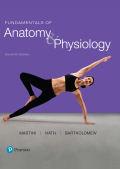
Fundamentals of Anatomy & Physiology (11th Edition)
11th Edition
ISBN: 9780134477336
Author: Martini
Publisher: PEARSON
expand_more
expand_more
format_list_bulleted
Question
Chapter 18, Problem 24CP
Summary Introduction
To discuss:
The individual with Type-1 and Type-2 diabetes urinate frequently and have increased thirst.
Concept introduction:
The Type-1 and Type-2 diabetes are the two types of diabetes mellitus. In this case, all the glucose within the body is absorbed by the kidney. Diabetes mellitus can also be caused due to the genetic abnormality.
Expert Solution & Answer
Want to see the full answer?
Check out a sample textbook solution
Students have asked these similar questions
Please fill in all blank questions, Thank you
please fill in missing parts , thank you
please draw in the answers, thank you
Chapter 18 Solutions
Fundamentals of Anatomy & Physiology (11th Edition)
Ch. 18 - Prob. 1CPCh. 18 - Describe paracrine communication.Ch. 18 - Identify five mechanisms of intercellular...Ch. 18 - What primary factor determines each cells hormonal...Ch. 18 - Prob. 5CPCh. 18 - Prob. 6CPCh. 18 - Prob. 7CPCh. 18 - If a person were dehydrated, how would the amount...Ch. 18 - Prob. 9CPCh. 18 - Prob. 10CP
Ch. 18 - Prob. 11CPCh. 18 - Prob. 12CPCh. 18 - When a persons thyroid gland is removed, signs of...Ch. 18 - Prob. 14CPCh. 18 - Prob. 15CPCh. 18 - Prob. 16CPCh. 18 - Prob. 17CPCh. 18 - Prob. 18CPCh. 18 - Prob. 19CPCh. 18 - Prob. 20CPCh. 18 - Increased amounts of light would inhibit the...Ch. 18 - Prob. 22CPCh. 18 - Prob. 23CPCh. 18 - Prob. 24CPCh. 18 - Prob. 25CPCh. 18 - Prob. 26CPCh. 18 - Prob. 27CPCh. 18 - Prob. 28CPCh. 18 - Prob. 29CPCh. 18 - The lack of which hormones would inhibit skeletal...Ch. 18 - Prob. 31CPCh. 18 - Prob. 32CPCh. 18 - Prob. 33CPCh. 18 - Prob. 1RQCh. 18 - Prob. 2RQCh. 18 - Prob. 3RQCh. 18 - Prob. 4RQCh. 18 - The two hormones released by the posterior lobe of...Ch. 18 - Prob. 6RQCh. 18 - Prob. 7RQCh. 18 - Prob. 8RQCh. 18 - Prob. 9RQCh. 18 - Prob. 10RQCh. 18 - Prob. 11RQCh. 18 - Prob. 12RQCh. 18 - Prob. 13RQCh. 18 - Prob. 14RQCh. 18 - Prob. 15RQCh. 18 - Prob. 16RQCh. 18 - Prob. 17RQCh. 18 - What is the primary difference in the way the...Ch. 18 - Prob. 19RQCh. 18 - Prob. 20RQCh. 18 - Prob. 21RQCh. 18 - Prob. 22RQCh. 18 - Prob. 23RQCh. 18 - Prob. 24RQCh. 18 - Prob. 25RQCh. 18 - Prob. 26RQCh. 18 - Prob. 27RQCh. 18 - Prob. 28RQCh. 18 - Prob. 29RQCh. 18 - Prob. 1CCCh. 18 - Prob. 2CC
Knowledge Booster
Learn more about
Need a deep-dive on the concept behind this application? Look no further. Learn more about this topic, biology and related others by exploring similar questions and additional content below.Similar questions
- a. On this first grid, assume that the DNA and RNA templates are read left to right. DNA DNA mRNA codon tRNA anticodon polypeptide _strand strand C с A T G A U G C A TRP b. Now do this AGAIN assuming that the DNA and RNA templates are read right to left. DNA DNA strand strand C mRNA codon tRNA anticodon polypeptide 0 A T G A U G с A TRParrow_forwardplease answer all question below with the following answer choice, thank you!arrow_forwardplease draw in the answeres, thank youarrow_forward
- A) What is being shown here?B) What is indicated by the RED arrow?C) What is indicated by the BLUE arrow?arrow_forwardPlease identify the curve shown below. What does this curve represent? Please identify A, B, C, D, and E (the orange oval). What is occurring in these regions?arrow_forwardPlease identify the test shown here. 1) What is the test? 2) What does the test indicate? How is it performed? What is CX? 3) Why might the test be performed in a clinical setting? GEN CZ CX CPZ PTZ CACarrow_forward
- Determine how much ATP would a cell produce when using fermentation of a 50 mM glucose solution?arrow_forwardDetermine how much ATP would a cell produce when using aerobic respiration of a 7 mM glucose solution?arrow_forwardDetermine how much ATP would a cell produce when using aerobic respiration to degrade one small protein molecule into 12 molecules of malic acid, how many ATP would that cell make? Malic acid is an intermediate in the Krebs cycle. Assume there is no other carbon source and no acetyl-CoA.arrow_forward
- Identify each of the major endocrine glandsarrow_forwardCome up with a few questions and answers for umbrella species, keystone species, redunant species, and aquatic keystone speciesarrow_forward19. On the diagram below a. Label the three pictures as: DNA; polypeptide; or RNA. b. Label the arrows as: translation or transcription/RNA processing. c. Add the following details to the diagram. Promoter region TATA box Transcription start site Transcription terminator Intron (A,B,C,D) Exons (1,2,3,4,5) Splice sites 5' cap 5' UTR (untranslated region) 3' poly A tail 3' UTR (untranslated region) Translational start (AUG) Translational stop (UGA, UAG, or UAA) N and C ends of polypeptide 0000arrow_forward
arrow_back_ios
SEE MORE QUESTIONS
arrow_forward_ios
Recommended textbooks for you
 Human Physiology: From Cells to Systems (MindTap ...BiologyISBN:9781285866932Author:Lauralee SherwoodPublisher:Cengage Learning
Human Physiology: From Cells to Systems (MindTap ...BiologyISBN:9781285866932Author:Lauralee SherwoodPublisher:Cengage Learning Nutrition Through The Life CycleHealth & NutritionISBN:9781337919333Author:Brown, Judith E.Publisher:Cengage Learning,
Nutrition Through The Life CycleHealth & NutritionISBN:9781337919333Author:Brown, Judith E.Publisher:Cengage Learning,


Human Physiology: From Cells to Systems (MindTap ...
Biology
ISBN:9781285866932
Author:Lauralee Sherwood
Publisher:Cengage Learning

Nutrition Through The Life Cycle
Health & Nutrition
ISBN:9781337919333
Author:Brown, Judith E.
Publisher:Cengage Learning,



What is a Primary and Secondary Metabolite?; Author: Unicity International;https://www.youtube.com/watch?v=TRNUURm0agM;License: Standard Youtube License